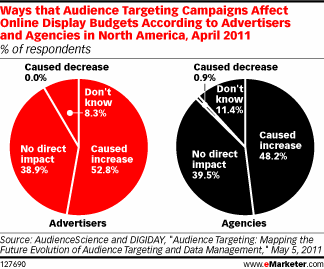Why Targeting Makes The Case For A Larger Ad Budget
Search and display can easily be classified as two separate industries, yet the crossover and interactions between them are substantial. Advertisers navigating the marketplace have the challenge of choosing where to spend their money, but due to the amount of data available to them via cookies tracking individuals wherever they go, and the ease of […]
Search and display can easily be classified as two separate industries, yet the crossover and interactions between them are substantial. Advertisers navigating the marketplace have the challenge of choosing where to spend their money, but due to the amount of data available to them via cookies tracking individuals wherever they go, and the ease of re-targeting, online advertisers are falling back in love with display.
Where We’ve Been In Search & Display Advertising
Before the introduction of Google AdWords 10 years ago, display advertising and online advertising were one in the same. We started the 2000’s with display dominating the interactive advertising landscape, but search quickly shoved display out of the way as advertisers saw the huge potential in being able to target user’s real-time intent or, keyword searches.
Today, with Q1 Online Ad Revenues reaching $7.3 billion, search is still number one with about 46% of the market. However, display is beginning to make a comeback, with its share in spend increasing over 8% from 2009. If the number of booths at an industry conference is an indicator, these numbers are right on – you can’t walk 5 feet without bumping into a company trying to be the next big thing in display.
Targeting A Big Factor In Growth Of Display Budgets
Coming a long way from early demographic targeting options, advertisers now have the option to build their own custom audiences around profiles of their exact customer base. Estimations are showing that over 97% of display advertisers will use some sort of audience targeting this year.
According to eMarketer, targeting has by far the largest impact on why advertisers are willing to spend more money on display, with 52.8% of advertisers saying that their increased ad budgets were directly impacted by increased targeting options.
Building your target audience (a subject for a future article) is typically done by using a combination of various different targeting options, including:
- Audience segmenting
- Contextual targeting
- Demographic targeting
- Re-targeting
Re-targeting, specifically search re-targeting, is a very effective way of closing the gap between an advertiser’s search engine marketing efforts and display advertising.
How Search & Display Are Coming Together
By using search re-targeting as a form of display targeting, advertisers bring the two largest segments of their online advertising budget together to work as one. Search re-targeting is made up of two different types of re-targeting: visitors to the advertiser’s website from search, and individuals searching on relevant keywords; both are effective in their own way.
The first type of search re-targeting is the most straightforward – show a display ad to someone who has previously visited an advertiser’s website from one of that advertisers search engine marketing ads. This gives the advertiser an opportunity to re-market to any of these visitors, with a display advertisement urging the customer to come back for more.
Advertisers can take this targeting a step further by segmenting the visitors into individuals that converted and individuals that did not convert. This differentiation then makes the display advertising much more effective, taking the individuals actions into account.
For an individual that converted, an advertiser may show them an ad asking them how they liked their purchase, and recommend similar products to them. For an individual that didn’t convert, they may see an ad inviting them back for a second chance, maybe with a new and more interesting promotion.
The above re-targeting may, however, drive a low amount of impressions, as it requires that the individual actually visit the advertisers website.
Depending on the advertisers search engine marketing budget, the number of visitors getting cookied may be low. To increase share, re-targeting can also be accomplished by monitoring the keywords that individuals are searching for, never having to visit the advertiser’s actual website.
This is accomplished by dropping a cookie on the individuals system from a partner site, and then dynamically monitoring the type of keywords that they are searching for on the search engines. If one of the keywords being “targeted” is searched for, that individual will see the advertisers’ display ads.
Using the above two targeting options together would be ideal, and from experience the site visited search re-targeting will almost always beat the keyword driven search re-targeting when a conflict occurs.
With the availability of new and more interesting targeting options with display advertising, we should continue to see advertisers move (or increase) budgets in that direction.
While both search engine marketing and display advertising are extremely important and efficient forms of online advertising in their own right, using them together can prove extremely beneficial for an advertisers online return-on-investment.
Opinions expressed in this article are those of the guest author and not necessarily Search Engine Land. Staff authors are listed here.
Related stories
